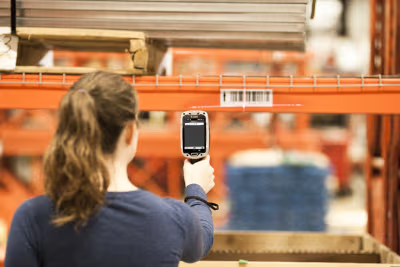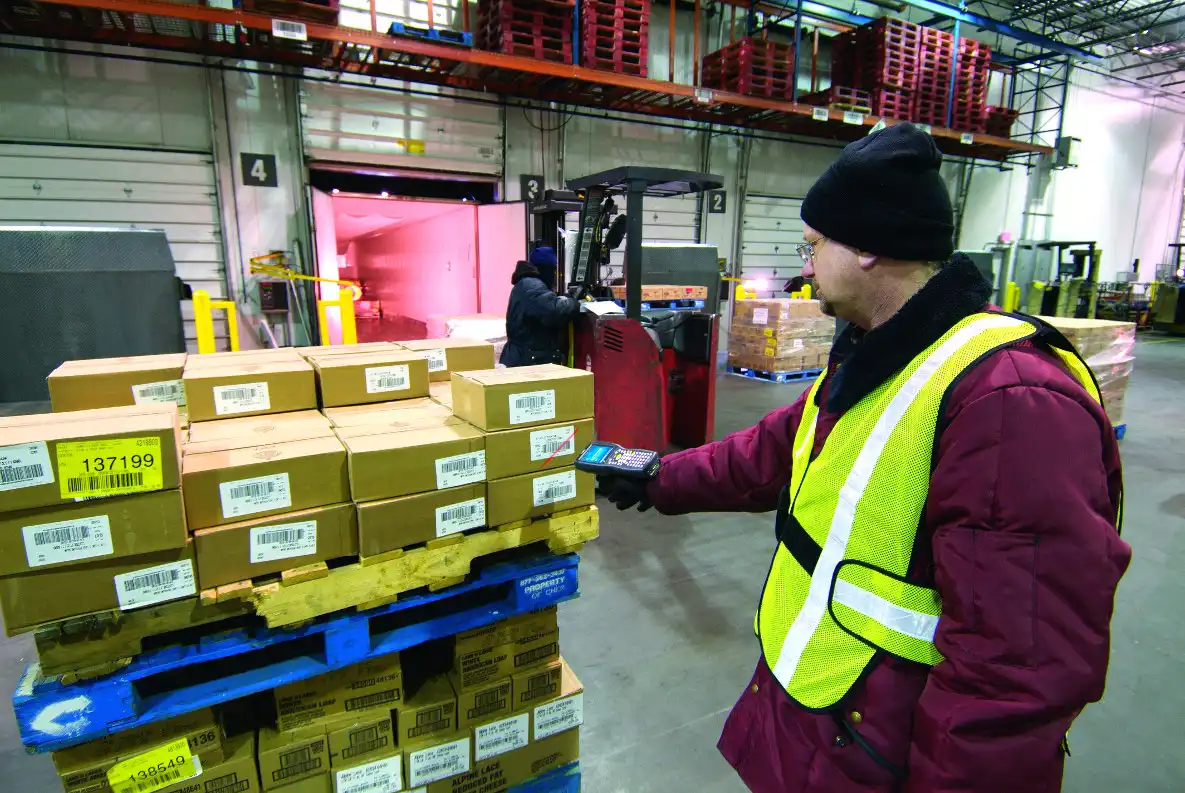Tests on terminals with integrated laser compared with consumer smartphones
At a time of democratized Internet purchasing and the race for the “cheapest”, it’s important to educate our customers and warn them of the hidden differences between professional terminals and off-the-shelf or “consumer” smartphones, both in terms of barcode reading and the rugged nature of the devices.
However, the purchase of a professional terminal should be based on the applications to be installed on it: tests should be carried out for specific applications.
Scanning barcodes with a terminal or with a “handheld”? differences …
A mobile terminal / PDA with integrated scanner is a more rugged smartphone with an integrated scanner. is a more rugged smartphone with a scanner (reads only 1D barcodes, i.e. a “laser” = old) or imager (1D + 2D codes) built into the head of the device, enabling barcodes to be read quickly with a dedicated button. Commonly known as a “zapette” or “scannette”.
Or with another addition to the terminal, called a “sled”, it can scan RFID chips, but we’re getting away from the subject of barcodes.

terminal, mobile computer / PDA with integrated scanner
The terminal therefore has intelligence (processor), memory like a PC, databases, in addition to the (touch) display screen and keyboards for some, and with user interaction programs. They now run on Android and can operate completely independently (from the PC), or even without a network, for quite some time. It will retain codes and format data according to the programs called up.
The scanner also known as barcode scanner, is simply a reader with a laser or imager that replaces the keyboard and must be connected to a PC to be useful, either by USB cable or BT, it has no memory like a PC and is not programmable (or very little). You have to stay close to the PC to monitor which square you’re in before pressing (like a keyboard).

barcode scanner
Integrated scanner terminal vs. handheld scanner
| Characteristic | Barcode scanner | Mobile barcode terminal or rugged smartphone |
|---|---|---|
| If Productivix sells them? | Not on their own, but integrated into a solution if necessary | YES: this is our core business, along with our apps |
| Wired or Bluetooth | Necessary | None |
| Linked to | A program running on a specific location, such as Excel | A server, gateway to a database |
| “intelligent or programmable” | very few | many applications, and customized |
| distance from station <10 m | unlimited | |
| Barcode scanner | Yes | Yes |
| Embedding part of the base | No | Yes |
| Keyboard and screen | No | Yes |
| Manual input of misread codes | No | Yes |
| Memory, microprocessor | No | Yes |
| Price level of product only | 50 to 300 €HT | 500 to 2000 €HT |
Why choose a scanner terminal integrated with a handheld scanner?
- From what we’ve seen, we can write the simplification equation that a terminal or smartphone brings to barcode scanning:
1 terminal / smartphone with integrated scanner = (1 PC + 1 handheld) + mobility
Smartphone variant with camera: The camera on your Android smartphone can also be used to scan barcodes: you’ll go a little slower than with an integrated imager, but we’ve got some apps here that let you test this function.
You can scan and do complicated processing, and store data, on the move with a terminal with an integrated barcode or RFID reader, which you can’t do with a handheld, connected by a wire or Bluetooth to the PC.
In any case, as with a PC, you need a program on the terminal to use it: an inventory, a parcel tracking application, order entry, etc…
What is the purpose of a mobile terminal with integrated scanner or camera?
- to be mobile, inside or outside the premises, without wires or PCs,
- to take on board your data, organize it and feed it back into the central database when necessary,
- be fast and error-free, keeping manual data entry to a minimum,
- embed intelligence and start-up data, a mini-database (e.g. list of orders to be received by supplier), calculations (distances between GPS points, rates, etc.),
- automatically add measurements to your data, without entering them: time (date, time), position (GPS), or other measurement (temperature, humidity) from a nearby sensor, to provide proof (of quality, veracity, control).
Barcode scanning with a commercial Android smartphone and free apps ?
Once you’ve got a camera on your smartphone, it’s easy to read barcodes with a Google Play application such as “Barcode scanner” for 1D or 2D (square) barcodes, including PDF417, QRcode, GS1 Databar, Aztec Code and, of course, Data Matrix with “QR Code Reader” (same procedure): install & try!
You’ll see on your screen the content of the barcode, which can be numbers or text, or links to websites.
We make applications that can activate the camera and read the barcode without needing these public applications, but the scanning operation will be similar. Our advantage lies in the fact that we’ll use the data retrieved to query a database integrated into the device or remote and display the designation of the item identified by the code read, for example, or integrate the code into a database with the GPS coordinate or date and time, for example.
By the way, if you’ve tested with these downloaded applications: have you measured the time it took to center the code in the sight, for the device to auto-focus (about 2 to 10 seconds) without absolutely moving and get the data, and have you tried in a poorly lit area or with two types of contrast (normally it’s impossible to read)? Have you tried reading a code that’s more than 5cm away? Impossible as standard!
Can you imagine doing this job all day with your thumb on the screen, watching out that the phone doesn’t do anything other than scan, because the touch screen will play tricks on you? And how would you copy the data read into your Excel spreadsheet, for example?
For all these points, we’ve worked to provide you with apps that use the camera to read one or more codes further away, in poor lighting conditions, and put the data read in the right place in your file or database. But the way the camera captures data still depends on the quality of the phone’s optics and sensor.
NB: there are ruggedized smartphones with cameras too.
Barcode scanning with a rugged smartphone with integrated laser or imager:
With an integrated scanner, we supply you with the driver that goes with the scanner and enables several on-the-fly transformations of the reading to provide additional ergonomic functions, or even to read several barcodes on the same page in one go and assign them to different fields on a form to further increase productivity. Scanners can achieve very high reading speeds of the order of 120 readings per minute, with luminous aiming and standardized lighting for dark or over-lit areas. A far cry from the (poor) performance of a smartphone camera!
In terms of ergonomics, there are several buttons on the device that trigger the scanner: you can also set them to suit your needs, whether you’re more left- or right-handed, more dexterous with your index finger or thumb, etc…
Batteries are designed to work a full 8-hour day (shift) in intensive scanning, usually with battery chargers only, with some changing without stopping the application, as there is in fact a second battery buffer in a rugged terminal!
Reading with an imager can be done in any direction and at distances near and far: we speak of “short, middle and long-range” depending on requirements, but the distance ranges are wide. Reading is done by moving, in a tenth of a second: there’s no need to stand still to read.
Imagers are also equipped with systems for detecting and correcting barcode defects, and some scanners can read a code through a transparent film or on a PC screen, or glossy codes engraved on metal!
Aspects of ruggedized terminals versus off-the-shelf smartphones
When it comes to failure rates, it’s a well-known fact [[VDC Research 2014: TCO Models for Mobile Computing]] that “a commercial smartphone in use equivalent to a ruggedized terminal will fail 3.5 times more often: which means a considerable loss of time paid to the operator and of service to the professional end-customer”.
In addition to the resistance factor, if an element such as a glass or lens is broken or damaged, the part can be changed in less than a week by the manufacturers of ruggedized terminals: it is durable, for the case of consumer terminals, the terminal is considered irreparable, or at least no quick service is provided as standard, except to change it completely, application licenses included!
Falling on a concrete floor, on the edge or on the glass is a very common occurrence in the workplace: ruggedized terminals are designed and specified in terms of thousands of drops, and the height is also indicated: try dropping your iPhone on edge voluntarily, without shuddering!
No need for protective covers: adding a cover means extra costs: ruggedized terminals can have one, but it’s optional, or even non-existent for certain models because they’re sufficiently ruggedized without a cover.
The same applies to falling into water, whether in a mountain stream or a puddle in the street: you can work immediately afterwards with a ruggedized terminal, but not with a commercial smartphone.
NB: there are also ruggedized smartphones with cameras.
Operating system (OS) updates: are simple and user-initiated on smartphones, but can lead to disappointment if :
- the user hasn’t really checked that his hardware will support it (memory, other options),
- they haven’t saved their data or key applications and checked that they will run on the next OS,
- the user doesn’t have a copy of the OS version to go back to if it doesn’t work properly.
- if the app used professionally supports this new version and does not produce errors or blockages in use.
On professional devices, the OS version change is carried out by a professional, and all such problems are analyzed before the device and/or its applications are rendered inoperative.
Conclusion about the benefits of a rugged terminal over a standard smartphone
We have seen that a rugged terminal is:
- quicker and more ergonomic to use: which boosts your teams’ performance,
- designed to be repairable, durable and even recyclable: a profitable investment over the long term.
That’s why these ruggedized mobile computers are priced to work, not play or look!
Before you buy: really know or test or both!
Many people come to us with rugged Android terminals bought on the net (admittedly cheap) and ask us to make a mobile application for them: it’s important to know that you can’t develop on just any hardware just because it’s Android. You need SDKs, which aren’t always supplied, and which take a long time to master and maintain.
Tests are therefore necessary before purchase, and we have provided an application for testing terminal scanners and a list of those that are valid:
